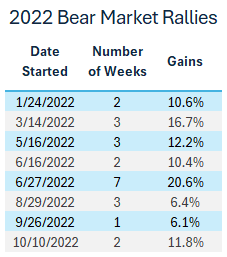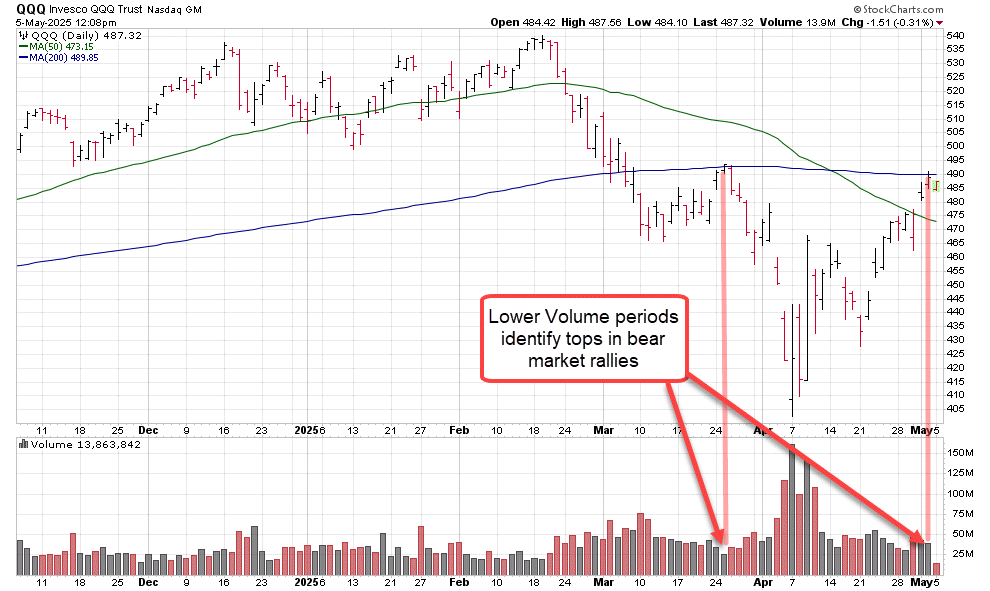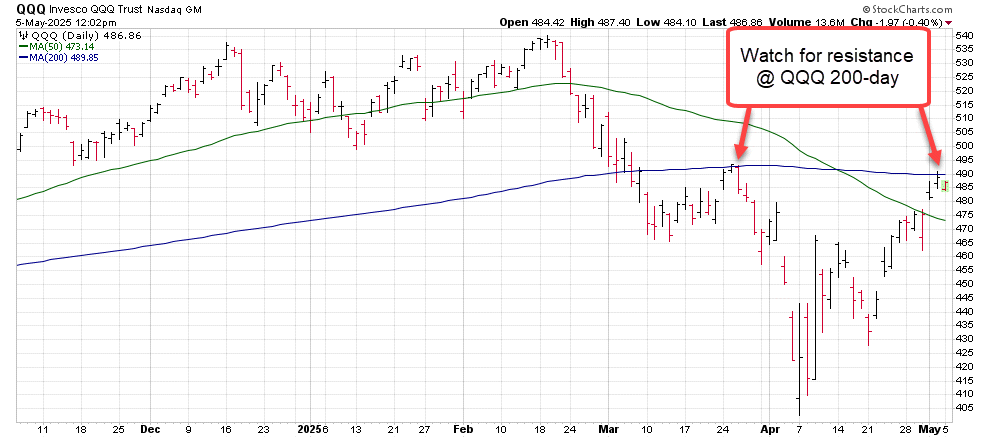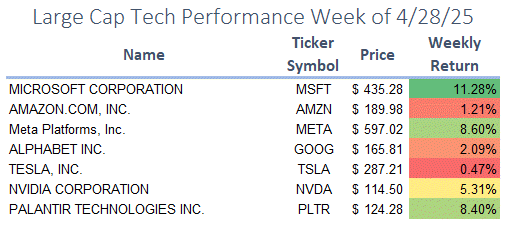The Market’s Biggest Battle This Week…
Here’s the Setup
Sure, Jerome Powell and the Fed will take some of the market’s attention this week as the Central Bank will reveal its latest interest rate decision on Wednesday afternoon. The announcement will cause some volatility, it always does, but nothing compared to what a few simple trendlines may do to stocks.
We’ll talk more about the Fed on Wednesday morning, for now the focus in on the market’s technicals and earnings.
Two weeks ago, you could cut the tension with a knife.
The earnings season opened on a strong note. The large financials reported better-than-expected results putting investors in the mood to test the waters with some small buying, but trading volume remained light.
Why wouldn’t it, we had just been through a washing machine of volatility that saw the Nasdaq 100 lose 15% following the unveiling of President Trumps tariffs. Adding to the pressure was the fact that analysts are now expecting a devaluation of the AI Bubble.
But then the big cap tech results started coming in giving investors instant confidence and starting one of the strongest 10-day rallies that the S&P 500 and Nasdaq 100 have seen in more than two years.
That’s where we sit today, at the highs of that rally that looks to have squeezed every bit of buying power that investors are willing to give right now. Now, they’re looking for a payoff. A continuation of the rally. The one thing that will keep them interested in holding stocks, not selling everything as the market falls to a recurring trend of “sucker” or “bear market rallies”.
Please remember….
Bear Market Rallies Happen
Bear market rallies are one of the most deceptive phases in a market downturn. They feel like the real recovery—but they’re not. These sharp, short-term moves higher happen while the broader trend remains bearish, often igniting hope that the worst is over just before another leg lower.
These rallies are fueled by a combination of oversold technical conditions, short-covering, and misplaced optimism—usually triggered by a single data point or policy shift that temporarily eases investor fear. But because the underlying fundamentals haven’t truly improved, the gains eventually fade. Stocks roll back over and head toward new lows.
We saw this in textbook fashion during the 2022 bear market. The Nasdaq 100 experienced eight separate bear market rallies before it finally found a bottom. Each of these rallies lasted about three weeks on average, and posted a sharp 11.8% average gain. But none of them marked the end of the bear—just temporary relief inside a downtrend that lasted 32 months from peak to 2022 Bear Market Rally Returnstrough.
 By the time the real bottom was in, the Nasdaq 100 had dropped a brutal 36.7% from its highs.
By the time the real bottom was in, the Nasdaq 100 had dropped a brutal 36.7% from its highs.
These rallies are not just noise—they’re part of the cycle. Recognizing them for what they are can help investors avoid getting caught in a bull trap and focus instead on preparing for the real turn in the market trend.
What Makes this Rally Look Like a Bear Market Rally?
The Nasdaq 100 may have ripped higher 15% higher over the last two weeks, but that doesn’t mean the bear market is over.
In fact, this rally checks nearly every box of a classic bear market rally—sharp, headline-driven, low-volume, and capped by technical resistance.
 Let’s start with the catalyst: a political pivot, not an economic shift.
Let’s start with the catalyst: a political pivot, not an economic shift.
President Trump’s softened tone on Jerome Powell and Chinese tariffs sparked relief, but relief is not recovery. These types of moves are reactionary—not rooted in improving fundamentals or institutional conviction.
The volume profile confirms that. The Nasdaq 100 has rallied more than 14% off the April 21 lows, yet volume remains below average, representing a lack or real long-term interest in stocks.
When bear market rallies take shape, they often do so on light participation—just enough momentum to create the illusion of strength, but not enough to sustain a new trend. If this were a real bull reversal, volume would be flooding in, not fading out.
Then there’s the technical ceiling. The $475–$480 level on the Nasdaq 100 aligns with two powerful resistance zones: the March lows and the bearish-sloping 50-day moving average. In bear markets, former support becomes resistance, and the 50-day trendline becomes a ceiling that bulls consistently fail to break.
 Add in the market’s hesitation—evidenced by the VIX refusing to drop—and it becomes clear: this is a rally without conviction. It’s emotional, not structural.
Add in the market’s hesitation—evidenced by the VIX refusing to drop—and it becomes clear: this is a rally without conviction. It’s emotional, not structural.
Last week, the VIX finally moved below the 25 level after stubbornly sticking at 25 despite a 6%move higher in stocks. That’s not normal. It’s a sign that the options market and institutional traders are rearming for the next volatility storm.
So, while the headlines look bullish, the internals still scream caution. Until volume remains high, resistance breaks, and the trend flips positive, this rally remains exactly what it looks like: a bear market rally, not the beginning of a new bull.
This is What Will Trigger the market this Week
Last week’s earnings reports did well for the market and stocks.
Earnings reports from META (META), Microsoft (MSFT), and even Amazon (AMZN) took some pressure off of the fears that there is an “AI Bubble” as all three companies confirmed plans to continue aggressive expansion to meet continued demand.
Over the last month, investors have been concerned that the AI industry may have formed a “Bubble” that made this group of stocks vulnerable to a deep dive in stock prices as the economy slows. So far, that is not the case.
Last week large cap technology stocks led the way higher but weren’t the standouts that we experienced in 2022 when the Mag Seven saved the market.
 This week’s biggest impact earnings call is Palantir (PLTR) on Monday following the market close.
This week’s biggest impact earnings call is Palantir (PLTR) on Monday following the market close.
The company is seen as one of the better positioned AI Services stocks in a time when AI – in general – is viewed as being overvalued or in a bubble.
Last week, Palantir rallied 8% higher in a clear example of a “buy the rumor” move that is familiar for the stock. In February, Palantir shares saw a similar rally of 8%, followed by a 49% jump after the company’s “beat and raise” earnings report.
Consider Palantir’s results to be the difference between the market having a chance to continue the rally and its end.
Later in the week’s we’ll begin to see the shift in earnings season that may play havoc on stocks.
Earnings from consumer and consumer discretionary stocks will start to roll in, bringing with them more dour outlooks for the economy and stocks.
Last week, CNBC, the New York Times and Reuters all reported of the pending slowdown in port traffic on the west coast. The slowdown suggests that the effects of the tariffs will soon be felt by consumers.
That, combined with an increase in negative outlooks from consumer-related stocks beginning later this week would begin the process of stocks retreating from their recent highs.
This Week’s Bottom Line
This rally feels good—but rallies in bear markets always do. The Nasdaq 100 may be up 15% in two weeks, but the drivers behind the move—low volume, political posturing, and resistance just overhead—make this look like yet another bear market rally, not the start of something sustainable.
We’ve seen this playbook before: oversold bounce, AI hype, and hope pinned on earnings.
But until volume confirms, trendlines flip, and the Fed gets truly out of the way, the market remains vulnerable.
Palantir’s earnings could be a turning point—but if it misses, the rug may get pulled fast.
Three Levels to Watch
On the S&P 500: A move back below the S&P 500 50-day moving average at $555 will signal that momentum is set to reverse and pressure stocks lower.
Nasdaq 100: The QQQ is running directly into resistance at its 200-day moving average at $490. A reversal from these highs combined with a move below the QQQ 50-day at $475 will signal the end of this bear market rally.
CBOE Volatility Index (Fear Gauge): This is simple, mark it down… a move back above 25 will trigger an increase in volatility and selling pressure across the market.
— Chris Johnson
Out of 23,281 Stocks... Only ONE is This Profitable and Undervalued. [sponsor]$3 billion+ in operating income. Market cap under $8 billion. 15% revenue growth. 20% dividend growth. No other American stock but ONE can meet these criteria... here's why Donald Trump publicly backed it on Truth Social. See His Breakdown of the Seven Stocks You Should Own Here.
Source: Money Morning
